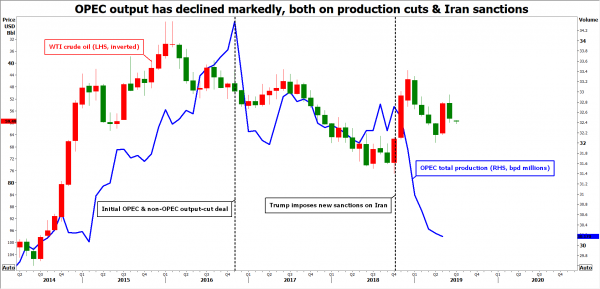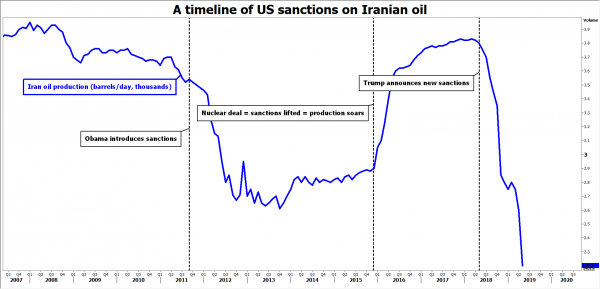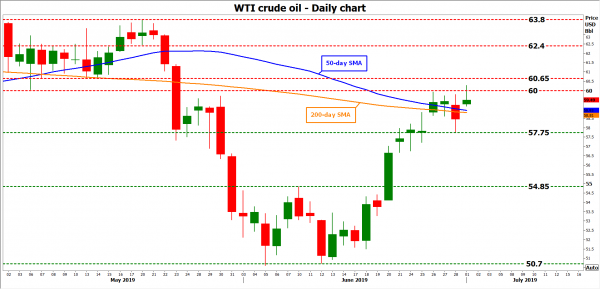The Organization of Petroleum Exporting Countries (OPEC) is meeting in Vienna, and the latest headlines suggest a nine-month extension of the existing production cuts is nearly certain. With OPEC’s output plans now clear, oil prices will take their cue from how the US-China trade talks and the situation with Iran unfold. Trade optimism may keep crude supported for now, with the risk of a corrective pullback increasing drastically if the talks show no real signs of progress later in the summer.
Oil prices started the week on a strong footing, with WTI briefly crossing above the psychological $60/barrel handle, following encouraging news on both the demand and supply fronts. First and foremost, the US and China agreed to restart trade negotiations, painting a brighter picture for future oil consumption. On the supply side, Russian President Vladimir Putin confirmed that he reached an accord with the Saudi Crown Prince to extend the OPEC+ production cuts.
The latter headline took the spotlight off the OPEC meeting that is currently underway in Vienna, as the only thing left to decide seems to be how long this extension will be. The latest headlines suggest the producers are leaning towards a nine-month extension, which if officially confirmed could provide a small boost to oil as the longer these output restrictions are in place, the better for prices from a supply perspective.
All about demand
Looking past this week though, what will probably matter most for crude’s overall direction is how the US-China trade talks unfold. In that sense, while the resumption of negotiations is clearly a positive sign, it’s still doubtful whether a comprehensive accord can be reached. The two sides remain far apart on some crucial issues, for example on intellectual property protection and a mechanism to enforce any agreement. Hence, the road to any deal is likely to be rocky and full of twists, if one is even possible that is.
For oil, that means that prices can still climb from here as the negotiations commence again and optimism runs high – but that the likelihood of a corrective pullback increases significantly from there on out. Not least due to the risk of another round of escalation later in the year, if Trump thinks China’s concessions are not big enough or that Beijing is stalling for time until next year’s US elections.
Iran is the wildcard
With OPEC’s near-term production plans now more or less clear, the biggest uncertainty on the supply side is Iran. Once OPEC’s second-largest exporter, the nation’s oil production has fallen drastically in recent months, as the US sanctions started to bite.
Tensions are near a boiling point, with recent reports suggesting that President Trump called off a military strike on Iran ‘at the last minute’, after Tehran shot down a US drone. The bottom line is that it’s difficult to see a diplomatic solution, so Iran’s output may still have room to fall if tensions escalate any further. This presents a ‘low-probability-but-high-impact’ upside risk for oil.
The technical outlook
Taking a technical look at WTI, another wave of advances could stall initially near the psychological 60.00 mark, with an upside violation seeing scope for a test of the 60.65 region – marked by the lows of May 13.
On the other hand, a pullback in the market may meet support around the June 28 lows at 57.75, where a bearish break may open the door for the 54.85 territory.















